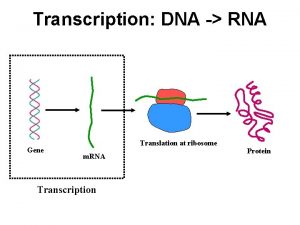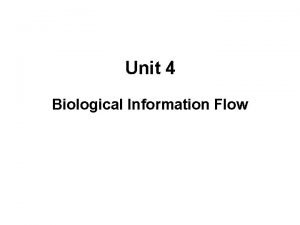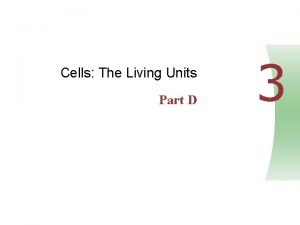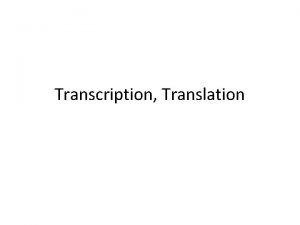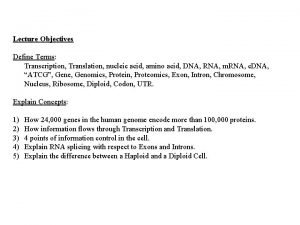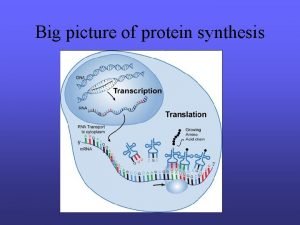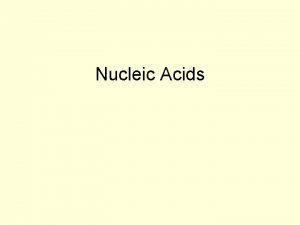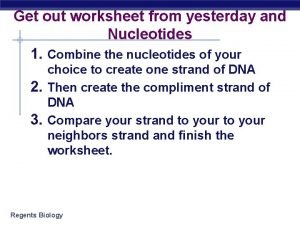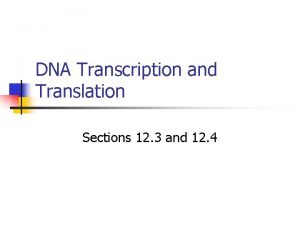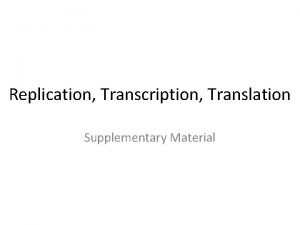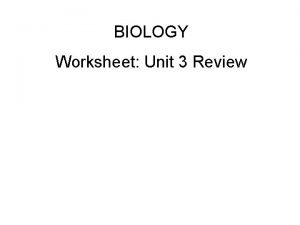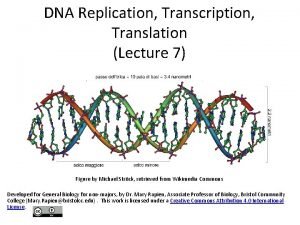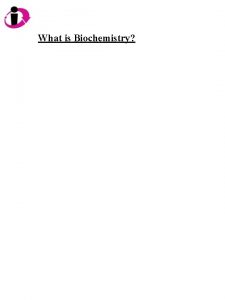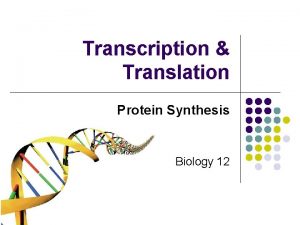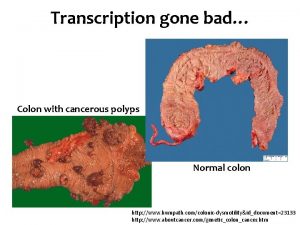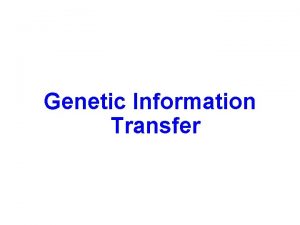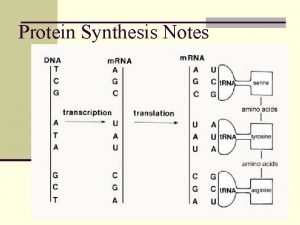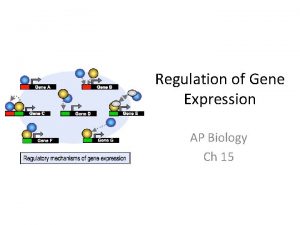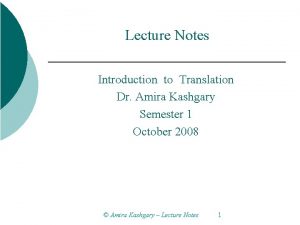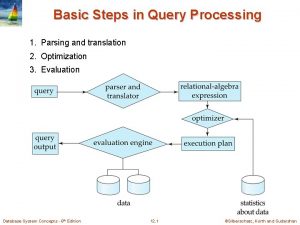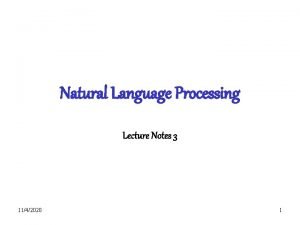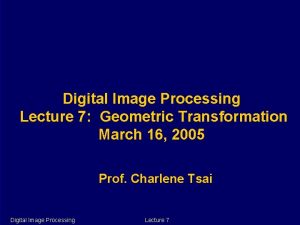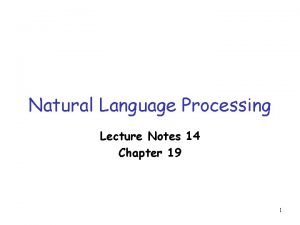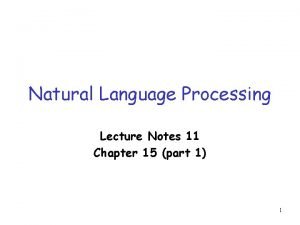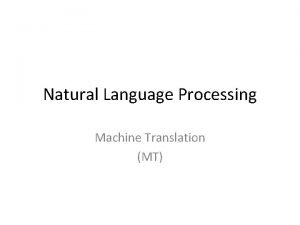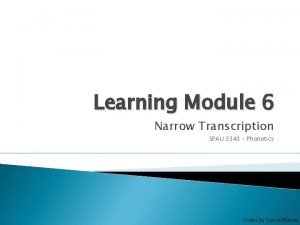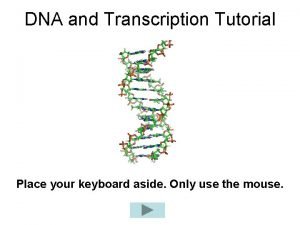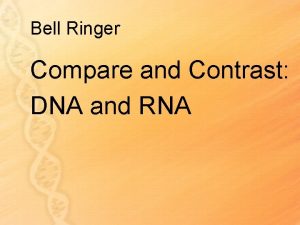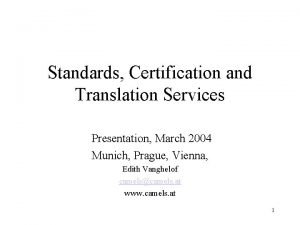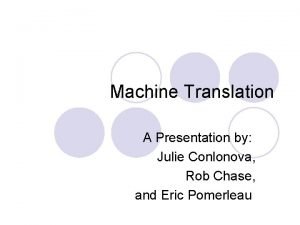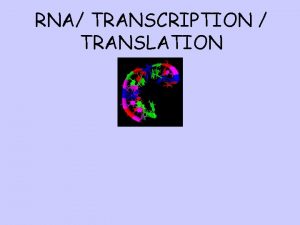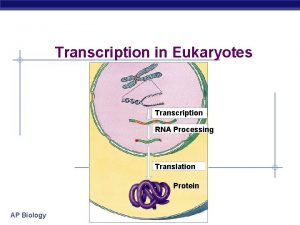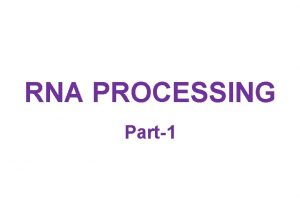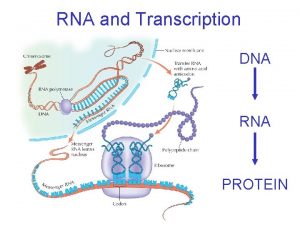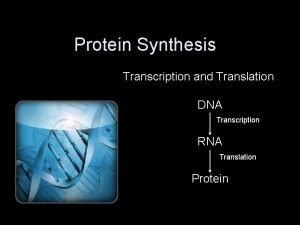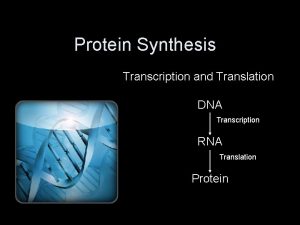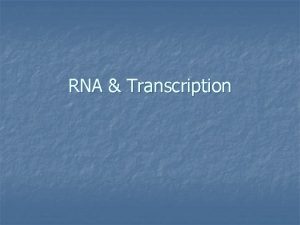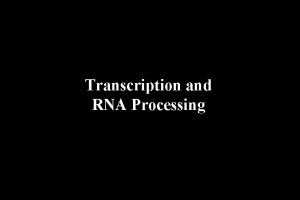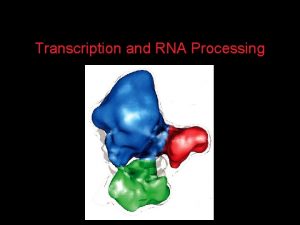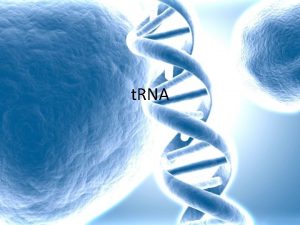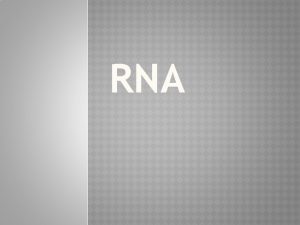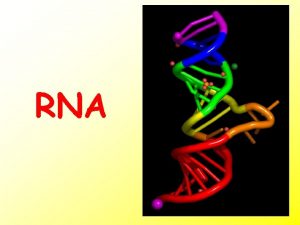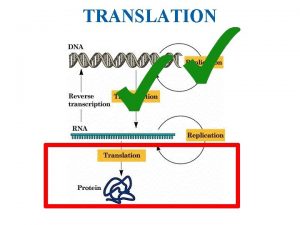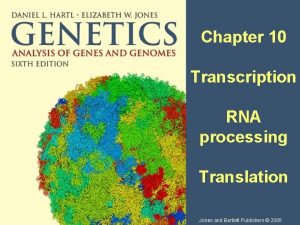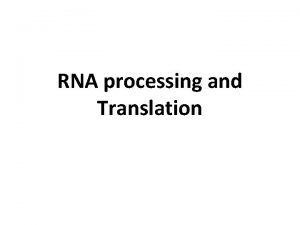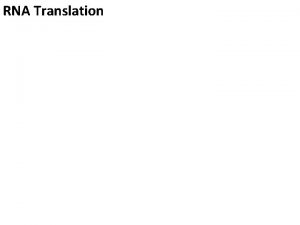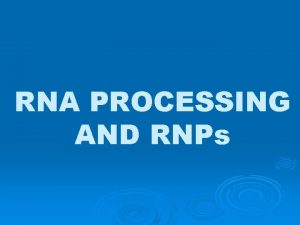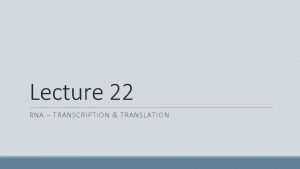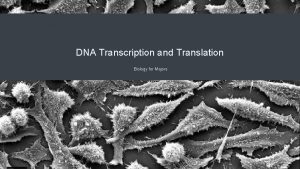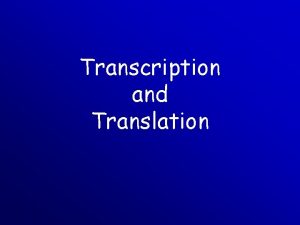17 Transcription RNA Processing and Translation Lecture Presentation
























































- Slides: 56

17 Transcription RNA Processing, and Translation Lecture Presentation by Cindy S. Malone, Ph. D, California State University Northridge © 2017 Pearson Education, Inc.

Chapter 17 Opening Roadmap © 2017 Pearson Education, Inc.

Introduction to Transcription, RNA Processing, and Translation • Proteins are the stuff of life • A cell builds the proteins it needs from instructions encoded in its genome • Transcribe DNA into RNA • Translate m. RNA into protein © 2017 Pearson Education, Inc.

An Overview of Transcription • RNA polymerases synthesize an m. RNA version of the instructions stored in DNA • Uses ribonucleoside triphosphates (NTPs) • Matches complementary bases to one strand of DNA • RNA is synthesized in the 5′ → 3′ direction • Only one strand of DNA is the template • Called the template strand • Other strand is the non-template, or coding strand • Matches the sequence of the m. RNA (except U for T) © 2017 Pearson Education, Inc.

Figure 17. 1 Non-template (coding) strand DNA RNA Template strand RNA Hydrogen bonds form between complementary base pairs DNA template © 2017 Pearson Education, Inc. Phosphodiester linkage is formed by RNA polymerase after base pairing occurs Incoming NTP (monomer)

An Overview of Transcription • Like DNA polymerases • RNA polymerases perform template-directed synthesis in the 5′-to-3′ direction • Unlike DNA polymerases • RNA polymerases do not require a primer to begin transcription • Bacteria have one RNA polymerase • Eukaryotes have at least three distinct types: • RNA polymerase I, II, and III © 2017 Pearson Education, Inc.

Initiation: How Does Transcription Begin in Bacteria? • Initiation is the first phase of transcription • RNA polymerase cannot initiate transcription on its own • In bacteria, sigma protein must bind to it first • RNA polymerase and sigma form a holoenzyme • RNA polymerase is the core enzyme because it has the active site © 2017 Pearson Education, Inc.

Initiation: How Does Transcription Begin in Bacteria? • Sigma binds to DNA segments called promoters that promote the start of transcription • Different sigma proteins bind to promoters with slightly different DNA base sequences • Allows organism to activate certain genes in response to environmental change © 2017 Pearson Education, Inc.

Bacterial Promoters • Bacterial promoters • Are 40 50 base pairs long • Have a – 10 box: a TATAAT sequence about 10 bases upstream of the transcription start site • Downstream means in the same direction that RNA polymerase moves • Upstream is the opposite direction • Also have a – 35 box: TTGACA sequence about 35 bases upstream of the transcription start site © 2017 Pearson Education, Inc.

Figure 17. 2 (a) RNA polymerase and sigma form a holoenzyme. Sigma Holoenzyme DNA Core enzyme (RNA polymerase) (b) Sigma recognizes and binds to the promoter. Promoter – 35 box – 10 box Downstream DNA Upstream DNA Sigma © 2017 Pearson Education, Inc. +1 site Active site RNA polymerase (interior view)

Events Inside the Holoenzyme • Transcription begins when the sigma part of the holoenzyme complex binds to the – 35 and – 10 boxes • Sigma can bind in only one orientation, so the orientation of the promoter determines • Which DNA strand will be used as the template • In which direction RNA polymerase will move © 2017 Pearson Education, Inc.

Events Inside the Holoenzyme • RNA polymerase opens the DNA double helix • Creates a transcription bubble • The template strand is threaded through the RNA polymerase active site • Incoming NTPs enter a channel in the enzyme and diffuse to the active site • Complementary NTPs pair with complementary DNA bases, and polymerization begins © 2017 Pearson Education, Inc.

Figure 17. 3 Promoter DNA +1 site – 10 box Downstream DNA – 35 box Sigma Active site 1. Initiation begins. Sigma binds to promoter region of DNA. RNA polymerase Coding strand Template strand +1 site NTPs Upstream DNA RNA © 2017 Pearson Education, Inc. 2. Initiation continues. RNA polymerase opens the DNA helix; transcription begins. Downstream DNA 3. Initiation is complete. Sigma is released from the promoter; RNA synthesis continues from DNA.

Elongation and Termination • During the elongation phase of transcription • RNA polymerase moves along the DNA template • Synthesizes RNA in the 5′ → 3′ direction • Transcription ends with termination • RNA polymerase transcribes a transcriptiontermination signal • Codes for RNA that forms a hairpin structure • Causes the RNA polymerase to separate from the RNA transcript © 2017 Pearson Education, Inc.

Figure 17. 4 Transcriptiontermination signal Downstream DNA Hairpin loop RNA polymerase RNA 1. Hairpin forms. RNA polymerase transcribes a transcriptiontermination signal, which codes for RNA that forms a hairpin. DNA RNA © 2017 Pearson Education, Inc. 2. Termination. The RNA hairpin causes the RNA to separate from the RNA polymerase, terminating transcription.

Transcription in Eukaryotes • Eukaryotic transcription has several differences: • Three RNA polymerases • More diverse promoters, including TATA box • Basal transcription factors instead of sigma proteins • At termination, a poly(A) signal is transcribed rather than a hairpin, and the RNA downstream is cut • Transcription occurs in the nucleus, and translation occurs in the cytoplasm © 2017 Pearson Education, Inc.

Table 17. 1 © 2017 Pearson Education, Inc.

Web Activity: RNA Synthesis © 2017 Pearson Education, Inc.

RNA Processing in Eukaryotes • In bacteria, m. RNAs are translated immediately, sometimes even before transcription is complete • In eukaryotes, the initial product of transcription is an immature primary transcript or pre-m. RNA • Primary transcripts must undergo RNA processing before they can be translated © 2017 Pearson Education, Inc.

The Discovery of Split Eukaryotic Genes • Sharp incubated viral m. RNA with single-stranded viral DNA • Loops formed • Stretches of DNA are not present in the mature m. RNA • Exons are the coding regions of eukaryotic genes that will be part of the final m. RNA product • Introns are the intervening noncoding sequences that will not be in the final m. RNA © 2017 Pearson Education, Inc.

Figure 17. 5 (a) Micrograph of DNA-RNA (b) Interpretation of micrograph hybrid Single-stranded DNA only Single-stranded DNA base paired with m. RNA © 2017 Pearson Education, Inc.

RNA Splicing • Primary RNA transcripts contain exons and introns • Introns are removed by splicing • Catalyzed by small nuclear ribonucleoproteins, or sn. RNPs • Form a complex called a spliceosome • Most complex macromolecular machine known • Composed of over 300 proteins • Splicing allows different m. RNAs and proteins to be produced from a single gene © 2017 Pearson Education, Inc.

RNA Splicing • Four steps to splicing: 1. sn. RNPs bind to a GU at the 5′ exon–intron boundary and to an A near the end of the intron 2. Other sn. RNPs form a spliceosome 3. The intron forms a lariat of a single-stranded stem plus a loop with A as its connecting point 4. The lariat is cut out and the two exons are linked. The intron is degraded © 2017 Pearson Education, Inc.

Figure 17. 6 (a) Introns must be removed from eukaryotic RNA transcripts. Intron 1 Intron 2 Template strand of DNA Exon 1 Exon 2 Exon 3 Primary RNA transcript Spliced transcript Primary RNA sn. RNPs Exon Intron Exon 1. sn. RNPs bind to start of intron and an A base within the intron. 2. sn. RNPs assemble to form the spliceosome. Spliceosome 3. Intron is cut; loop forms. Excised intron Spliced m. RNA Exon © 2017 Pearson Education, Inc. Exon 4. Intron is released as a lariat; exons are joined together.

Adding Caps and Tails to Transcripts • Primary RNA transcripts are also processed by the addition of • A 5 cap—a modified guanine nucleotide that enables ribosomes to bind and protects from degradation • A 3′ poly(A) tail— 100– 250 adenine nucleotides; is needed for translation and protects from degradation • After splicing and addition of the cap and tail, the product is a mature m. RNA • Mature m. RNAs contain untranslated regions (UTRs) at both ends © 2017 Pearson Education, Inc.

Figure 17. 7 5′ cap Poly(A) signal Poly(A) tail AA A AAAAAA AAA 5′ untranslated region © 2017 Pearson Education, Inc. Coding region 3′ untranslated region

Ribosomes Are the Site of Protein Synthesis • In translation, the sequence of bases in an m. RNA is converted to an amino acid sequence in a protein • Ribosomes catalyze translation of the m. RNA sequence into protein • In bacteria, ribosomes begin translating an m. RNA before transcription is complete • Multiple ribosomes attached to an m. RNA form a polyribosome • Many copies of a protein are produced from one m. RNA © 2017 Pearson Education, Inc.

Figure 17. 8 (a) Electron micrograph of coupled transcription and translation in bacteria Ribosomes m. RNA DNA 0. 1 µm (b) Schematic depiction of coupled transcription and translation in bacteria 5′ end of m. RNA Ribosome translates m. RNA as it is being synthesized by RNA polymerase Polyribosome (numbers indicate order in which ribosomes attached to m. RNA) 3 2 2 Protein 1 1 1 Ribosome RNA polymerase Start of gene © 2017 Pearson Education, Inc. End of gene

Translation in Bacteria and Eukaryotes • In eukaryotes, transcription and translation are separated • m. RNAs are synthesized and processed in the nucleus • Mature m. RNAs are transported to the cytoplasm for translation by ribosomes • Polyribosomes form © 2017 Pearson Education, Inc.

How Does an m. RNA Triplet Specify an Amino Acid? • There were two hypotheses regarding how the amino acid sequence is coded by a sequence of nucleotides 1. m. RNA codons and amino acids interact directly 2. Crick proposed that an adapter molecule holds amino acids in place while interacting with a codon • The adapter molecule was later found to be a small RNA called transfer RNA (t. RNA) • t. RNAs bind to amino acids • Transfer them to the growing polypeptide © 2017 Pearson Education, Inc.

Figure 17. 9 (a) Hypothesis 1: Amino acids interact directly with m. RNA codons. Peptide bond Amino acids m. RNA Codon (b) Hypothesis 2: Adapter molecules hold amino acids and interact with m. RNA codons. Amino acids Adapter molecules m. RNA © 2017 Pearson Education, Inc. Codon

Figure 17. 10 What happens to the amino acids attached to t. RNAs? Aminoacyl t. RNAs transfer amino acids to growing polypeptides. Aminoacyl t. RNAs do not transfer amino acids to growing polypeptides. 1. Attach radioactive leucine molecules to t. RNAs. t. RNA Radioactive leucine 2. Add these aminoacyl t. RNAs to in vitro translation system. Follow fate of the radioactive amino acids. m. RNA and ribosomes Radioactive amino acids will be found in polypeptides. Radioactive amino acids will not be found in polypeptides. Radioactive signal (counts/minute) Radioactive amino acids start attached to t. RNA Polypeptides Radioactive amino acids are rapidly incorporated into polypeptides t. RNA Time (minutes) Aminoacyl t. RNAs transfer amino acids to growing polypeptides. © 2017 Pearson Education, Inc.

What Do t. RNAs Look Like? • t. RNAs are relatively short: 75– 85 nucleotides long • They can form secondary structure by folding into a stem-and-loop • A CCA sequence at the 3′ end is the binding site for amino acids • An aminoacyl t. RNA is a t. RNA linked to its amino acid • The loop at the opposite end forms the anticodon • Has a sequence of three nucleotides • Can base-pair with the m. RNA codon © 2017 Pearson Education, Inc.

Figure 17. 11 (a) Secondary structure of aminoacyl t. RNA Ser Amino acid Attachment site for amino acid Stems are created by hydrogen bonding between complementary base pairs Loops consist of unpaired bases Anticodon m. RNA Codon (b) Tertiary structure of aminoacyl t. RNA Amino acid attached to CCA (reading 5′ to 3′) at 3′ end Singlestranded loops r Doublestranded stems Anticodon binds to m. RNA codon Anticodon m. RNA Codon © 2017 Pearson Education, Inc. Se

How Are Amino Acids Attached to t. RNAs? • ATP is required to attach t. RNA to an amino acid • Enzymes called aminoacyl-t. RNA synthetases “charge” the t. RNA by • Catalyzing the addition of amino acids to t. RNAs • For each of the 20 amino acids • There is a different aminoacyl t. RNA synthetase • There are one or more t. RNAs © 2017 Pearson Education, Inc.

Figure 17. 12 Amino acid Aminoacyl t. RNA Aminoacylt. RNA synthetase t. RNA © 2017 Pearson Education, Inc.

How Many t. RNAs Are There? • There are 61 different codons but only about 40 t. RNAs in most cells • Crick proposed the wobble hypothesis • The anticodon of t. RNAs can still bind successfully • To a codon whose third position • Requires a nonstandard base pairing • One t. RNA is able to base-pair with more than one type of codon © 2017 Pearson Education, Inc.

The Structure and Function of Ribosomes • Ribosomes contain • Many proteins • Ribosomal RNA (r. RNA) • Ribosomes can be separated into two subunits 1. The small subunit holds the m. RNA in place 2. The large subunit is where peptide bonds form • During translation • Three t. RNAs line up within the ribosome © 2017 Pearson Education, Inc.

The Structure and Function of Ribosomes • Three t. RNAs are bound to the corresponding codon in the m. RNA • The t. RNAs fit into three sites in the ribosome: 1. The A site is the acceptor site for an aminoacyl t. RNA 2. The P site is the peptidyl site where a peptide bond forms 3. The E site is where t. RNAs without amino acids exit the ribosome © 2017 Pearson Education, Inc.

Figure 17. 13 (b) Model of ribosome during translation (exterior view) (a) Diagram of ribosome during translation (interior view) Peptide-bond formation occurs here The P site holds the t. RNA with growing polypeptide attached The A site holds an aminoacyl t. RNA The E site holds a t. RNA that will exit Ribosomal RNA (r. RNA) Large subunit t. RNA Anticodon m. RNA © 2017 Pearson Education, Inc. Codon Protein Small subunit

The Structure and Function of Ribosomes • The ribosome is a molecular machine that synthesizes proteins in a three-step sequence: 1. An aminoacyl t. RNA carrying the correct anticodon for the m. RNA codon enters the A site 2. A peptide bond forms between the amino acid on the A-site t. RNA and the polypeptide on the P-site t. RNA 3. The ribosome moves down the m. RNA by one codon and all three t. RNAs move down one position • The t. RNA in the E site exits • The A site is available for another t. RNA to bind © 2017 Pearson Education, Inc.

The Structure and Function of Ribosomes • The protein grows by one amino acid with each repeat of the three steps • Amino acids are always added to the carboxyl end (C-terminus) of the polypeptide • Translation has three phases: 1. Initiation 2. Elongation 3. Termination © 2017 Pearson Education, Inc.

Initiating Translation • The initiation phase of translation begins near the AUG start codon • The small ribosomal subunit binds to the m. RNA • At the ribosome binding site (Shine–Dalgarno sequence) • About 6 bases upstream from the start codon • Mediated by initiation factors • The first t. RNA is called the initiator t. RNA • It carries a modified methionine (f-Met) in bacteria © 2017 Pearson Education, Inc.

Initiating Translation • Translation initiation is a three-step process in bacteria: 1. The m. RNA binds to a small ribosomal subunit 2. The initiator t. RNA bearing f-Met binds to the start codon 3. The large ribosomal subunit binds so that the initiator t. RNA is in the P site • Translation is now ready to begin © 2017 Pearson Education, Inc.

Figure 17. 14 Ribosome binding site Start codon Initiation factors 1. m. RNA binds to small subunit. © 2017 Pearson Education, Inc. NA m. R Small subunit of ribosome Large subunit of ribosome Aminoacyl t. RNA Start codon 2. Initiator aminoacyl t. RNA binds to start codon. 3. Large subunit of ribosome binds, completing ribosome assembly.

Elongation: Extending the Polypeptide • At the start of elongation • The initiator t. RNA is in the P site • The E and A sites are empty • An aminoacyl t. RNA binds to the codon in the A site • The amino acid on the P-site t. RNA is transferred to the amino acid on the A-site t. RNA © 2017 Pearson Education, Inc.

Is the Ribosome an Enzyme or a Ribozyme? • The active site of the ribosome is entirely ribosomal RNA • Ribosomal RNA catalyzes peptide bond formation • The ribosome is a ribozyme • An RNA with catalytic activity • This supports the RNA world hypothesis © 2017 Pearson Education, Inc.

Moving Down the m. RNA • Translocation occurs when the ribosome slides one codon toward the 3′ end of the m. RNA • Elongation factors help move the ribosome • Translocation accomplishes three things: 1. The uncharged t. RNA from the P site moves into the E site and is ejected from the ribosome 2. The t. RNA attached to the growing protein moves into the P site 3. Opens the A site to expose a new codon, which is available to accept a new aminoacyl t. RNA © 2017 Pearson Education, Inc.

Figure 17. 15 Part 1 Peptide bond Ribosome Peptidyl site Ribosome’s active site t. RNA Aminoacyl site Exit site m. RNA Start codon 1. Incoming aminoacyl t. RNA © 2017 Pearson Education, Inc. 2. Peptide-bond formation 3. Translocation

Moving Down the m. RNA • The three steps of translocation repeat at each codon along the m. RNA 1. Arrival of the aminoacyl t. RNA in the A site 2. Peptide bond formation 3. Translocation © 2017 Pearson Education, Inc.

Figure 17. 15 Part 2 Exit tunnel 4. Incoming aminoacyl t. RNA © 2017 Pearson Education, Inc. 5. Peptide-bond formation 6. Translocation Elongation cycle continues

Terminating Translation • Termination occurs when the A site encounters a stop codon • A protein called a release factor enters the A site • Resembles t. RNAs in size and shape • But does not carry an amino acid • Hydrolyzes the bond linking the P-site t. RNA to the polypeptide chain • The newly synthesized polypeptide, t. RNAs, and ribosomal subunits separate from the m. RNA © 2017 Pearson Education, Inc.

Figure 17. 16 Large subunit Hydrolysis of bond linking t. RNA and polypeptide Protein release factor t. RNA m. RNA STOP codon 1. Release factor binds to stop codon. © 2017 Pearson Education, Inc. m. RNA Small subunit 2. Polypeptide and uncharged t. RNAs are released. 3. Ribosome subunits separate.

Web Activity: Synthesizing Proteins © 2017 Pearson Education, Inc.

Post-Translational Modifications • Most proteins go through an extensive series of processing steps • Called post-translational modification • Before they are completely functional • Folding determines a protein’s shape and function • Molecular chaperones speed protein folding • Enzymes may add sugar or lipid groups or phosphate groups © 2017 Pearson Education, Inc.

Figure 17. 17 Nucleus DNA Polymerase Pre-m. RNA 1. Transcription 2. RNA processing Cap Primary transcript (pre-m. RNA) Tail Mature m. RNA Cytoplasm 3. Translation 4. Post-translational modification (folding, glycosylation, transport, activation, degradation of protein) © 2017 Pearson Education, Inc. Ribosome m. RNA Polypeptide Active protein
 Dna to rna transcription
Dna to rna transcription Transcription translation venn diagram
Transcription translation venn diagram Rna transcription
Rna transcription Dna to rna transcription
Dna to rna transcription Dna coloring transcription and translation
Dna coloring transcription and translation Perbedaan replikasi virus dna dan rna
Perbedaan replikasi virus dna dan rna Transcription and translation bbc bitesize
Transcription and translation bbc bitesize Dna transcription and translation
Dna transcription and translation Dna replication transcription and translation
Dna replication transcription and translation Translation biology
Translation biology Picture of protein synthesis
Picture of protein synthesis Translation or transcription
Translation or transcription Biology transcription and translation
Biology transcription and translation Transcription and translation practice worksheet answer key
Transcription and translation practice worksheet answer key Venn diagram dna and rna
Venn diagram dna and rna Transcription
Transcription Transcription translation replication
Transcription translation replication Transcription translation replication
Transcription translation replication Dna meaning
Dna meaning Translation transcription
Translation transcription Transcription or translation
Transcription or translation Translation transcription
Translation transcription Semiconservative replication
Semiconservative replication Unlike dna rna contains
Unlike dna rna contains Swf
Swf 01:640:244 lecture notes - lecture 15: plat, idah, farad
01:640:244 lecture notes - lecture 15: plat, idah, farad Difference between semantic and communicative translation
Difference between semantic and communicative translation Transformation of functions
Transformation of functions Translation lecture notes
Translation lecture notes Steps of query processing
Steps of query processing Natural language processing nlp - theory lecture
Natural language processing nlp - theory lecture Image processing lecture notes
Image processing lecture notes Natural language processing lecture notes
Natural language processing lecture notes Natural language processing nlp - theory lecture
Natural language processing nlp - theory lecture Natural language processing lecture notes
Natural language processing lecture notes Geometric transformation in digital image processing
Geometric transformation in digital image processing Natural language processing lecture notes
Natural language processing lecture notes Natural language processing lecture notes
Natural language processing lecture notes Voice translation-rule
Voice translation-rule Semantic translation và communicative translation
Semantic translation và communicative translation Neighborhood processing in image processing
Neighborhood processing in image processing Secondary processing of wheat
Secondary processing of wheat Interactive processing
Interactive processing Lecture presentation software
Lecture presentation software Machine translation in natural language processing
Machine translation in natural language processing Read the transcriptions and write the words
Read the transcriptions and write the words Broad narrow transcription
Broad narrow transcription Dna and transcription tutorial
Dna and transcription tutorial Rna transfer
Rna transfer Sinciput presentation
Sinciput presentation Leopold's maneuver
Leopold's maneuver Certified presentation translation
Certified presentation translation Machine translation presentation
Machine translation presentation Top down vs bottom up processing
Top down vs bottom up processing Gloria suarez
Gloria suarez Bottom-up processing examples
Bottom-up processing examples Point processing
Point processing
